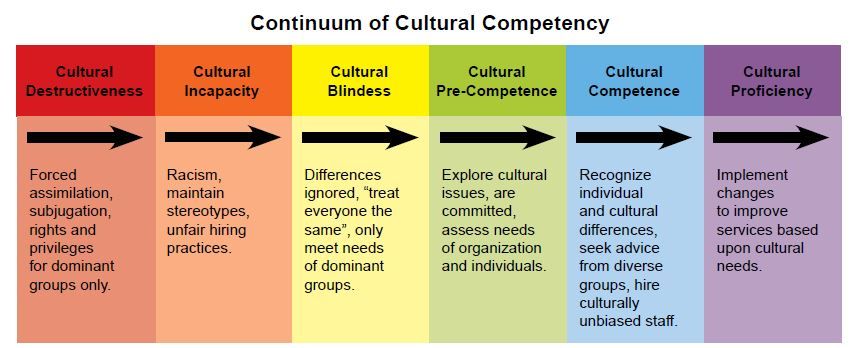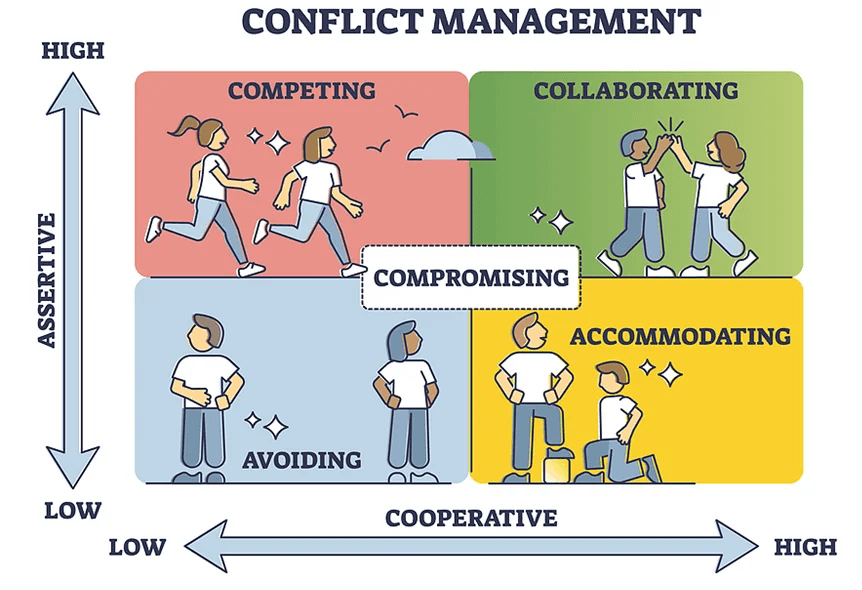Challenging inappropriate behaviour
You may use the tools and models in this section individually or collectively to address specific FRS requirements. You will find:
- Key considerations, including the impact of challenging inappropriate behaviour
- Models and frameworks for recognising and addressing inappropriate behaviour
- De-escalation techniques and conflict resolution methods tailored to the FRS environment
- Practical tools and techniques to support all colleagues
Key considerations
Constructive Engagement
Challenging inappropriate behaviour involves engaging with people in a constructive and respectful manner to address behaviours that may harm team dynamics or operational effectiveness.
Opportunity for Growth
Challenging inappropriate behaviour presents an opportunity for individuals to give feedback and support to their colleagues. This encourages personal and professional growth in the team.
Positive Impact
Challenging inappropriate behaviour can have a positive impact on team dynamics, fostering open communication, trust and collaboration among team members.
Emphasising the importance of challenging inappropriate behaviour
Recognising and addressing inappropriate behaviour in a positive, proactive manner is essential for maintaining a supportive, high-functioning team. By encouraging team members to respectfully challenge behaviours that do not align with the values and goals of the FRS, leaders can foster a culture of continual improvement and excellence. This approach empowers individuals to contribute to a positive work environment where everyone feels valued, respected and motivated to perform to the best of their ability.
Models and Frameworks
Emotional Intelligence Framework
Emotional intelligence (EI) refers to the ability to recognise, understand and manage our own emotions and those of others. EI plays a critical role in enabling effective communication, conflict resolution and team cohesion.
Daniel Goleman’s framework identifies four key components of emotional intelligence: self-awareness, self-management, social awareness and relationship management. Together, they serve as a foundation for enhancing EI in various contexts, including the workplace.
| Daniel Goleman’s emotional intelligence framework | ||
| Self
Personal competence |
Other
Social competence |
|
| Recognition | Self-awareness
Emotional self-awareness Accurate self-awareness Self-confidence |
Social awareness
Empathy Service orientation Organisational awareness |
| Regulation | Self-management
Self-control Trustworthiness Conscientiousness Adaptability Achievement drive Initiative |
Relationship management
Developing others Influence Communication Conflict management Leadership Change catalyst Building bonds Teamwork and collaboration |
Application of emotional intelligence framework
Enhancing EI involves developing key competencies such as emotional awareness, self-regulation, empathy and social skills among team members. Activities for enhancing EI may include:
- Conducting self-assessment exercises to increase awareness of our own emotional triggers and response patterns
- Practising mindfulness and relaxation techniques to improve self-regulation and stress management
- Engaging in perspective-taking exercises to foster empathy and understanding of the emotions and perspectives of others
- Participating in role-playing or communication-skills training to enhance social skills and interpersonal effectiveness
Cultural Competence Continuum
A cultural competence framework enables FRS to assess their ability to handle cultural differences. This entails having the knowledge, skills and attitudes necessary to recognise, respect and respond to the cultural differences of team members.
The original Cultural Competence research, developed by Terry Cross et al. in 1989, outlines stages of cultural competence, ranging from cultural destructiveness to cultural proficiency, and has since been applied to a variety of contexts. It provides a roadmap for individuals and organisations to assess and improve their cultural competence.

De-escalation techniques and conflict resolution
Conflict-resolution models
Conflict-resolution models provide structured approaches for addressing and resolving conflicts. One such model is the Thomas-Kilmann Conflict Mode Instrument (TKI), developed by Kenneth Thomas and Ralph Kilmann. The TKI identifies five conflict-handling styles: competing, collaborating, compromising, avoiding and accommodating. Each style is suited to different situations and preferences.

Step-by-step approach for de-escalating conflict using the Thomas-Kilmann Conflict Mode Instrument:
- Identify the issue: clearly define the source of the conflict, focusing on observable behaviours rather than personal attributes
- Actively listen: practise active listening to understand the perspectives and underlying concerns of all parties involved
- Choose the appropriate conflict model: use the TKI framework to determine the most suitable conflict-handling style for the situation
- Seek mutual understanding: encourage open dialogue and brainstorming to find common ground and explore potential solutions
- Negotiate and collaborate: work together to generate mutually beneficial agreements that address the needs and interests of all parties
- Follow up and monitor: implement agreed solutions and monitor progress, making adjustments as needed to prevent future conflicts
Feedback Models
There are many ways to give proactive, constructive feedback on inappropriate behaviour. One such example is the AID model.
AID feedback model
A = action: what was the specific, observed action or behaviour?
I = impact: what impact did the action or behaviour have on the person giving feedback and/or others?
D = do differently: what needs to change?
Example:
A: ‘I noticed during the meeting that you interrupted several times when others were speaking.’
I: ‘This made it difficult for others to express their thoughts and disrupted the meeting.’
D: ‘In future meetings, it is important to allow others to speak without fear of interruption.’
Tools and techniques for effective communication
The CLEAR Model
Developed by Jack Gibbs, the CLEAR Model offers a structured approach to assertive communication.
| Gibbs’ CLEAR Model | |
| Clarify | Clearly express your thoughts, feelings and expectations, using specific, descriptive language |
| Listen | Actively listen to the perspectives of others, demonstrating empathy and understanding |
| Express | Express your own needs, concerns and boundaries assertively, using ‘I’ statements and avoiding blame |
| Assert | Assert your position respectfully and confidently, maintaining composure and firmness |
| Review | Review and confirm mutual understanding, seeking clarification and addressing any remaining concerns |
Assertive Communication
Encourage individuals to express their concerns or objections assertively, using ‘I’ statements to give their perspective without blaming or accusing others.
Questioning Techniques
Several techniques can be used for questioning. Two examples are open-ended questions and reflective questions.
Open-ended questions:
- Encourage open dialogue and exploration of underlying issues by asking open-ended questions that prompt reflection and discussion
- Example of an open-ended question: ‘What is your perspective on this issue?’
Reflective questions:
- Use reflective questions to encourage individuals to consider the impact of their behaviour on others and to explore alternative viewpoints
- Example of a reflective question: ‘How do you think your actions might be perceived by your colleagues?’
Example: During a team brainstorming session, a team member suggests an unconventional approach to a project. The project manager asks an open-ended, reflective question: ‘I’d like you to elaborate more on your idea. How do you see it benefiting our project?’
Positive outcome: The team member feels valued and respected for their input. This leads to a fruitful discussion in which the team explores the idea further and integrates aspects of it into the project plan.
Active Listening
Paraphrasing:
- Demonstrate active listening by summarising and paraphrasing what the other person has said, ensuring understanding and validation
- Example of a question using paraphrasing: ‘So, if I understand correctly, you are feeling frustrated because you believe your contributions are being undervalued?’
Example: A colleague expresses frustration about a recent change in procedures. Their line manager actively listens and paraphrases their concerns: ‘It sounds like you are feeling overwhelmed by the new procedures and uncertain about how they will affect your work.’
Positive outcome: The colleague feels understood and validated. This leads to a productive discussion in which the supervisor addresses their concerns and offers support in adapting to the changes.
Non-verbal cues
Pay attention to non-verbal cues such as body language and facial expressions, which can provide valuable insights into the speaker’s emotions and intentions. This can be more challenging when meetings are held virtually. Consider cues such as the other person switching off their camera or appearing distracted.
Example: ‘I noticed you crossed your arms when discussing this issue. Is there something you’re feeling uneasy about?’
Clear Expectation Setting
Clearly outline expectations for behaviour and performance, providing specific examples of desired conduct and the potential consequences of noncompliance.
Example: A team leader notices a colleague consistently arrives late to team meetings. During a private conversation, the leader addresses the issue assertively: ‘I notice you have frequently been arriving late to our team meetings. It is important for everyone to be punctual so we can start on time and respect each other’s time commitments. Can we discuss any challenges you are facing that might be causing this?’
Positive outcome: The colleague appreciates the direct, respectful approach and opens up about personal issues causing them to be late. Together, they find a solution. The colleague starts attending meetings on time, improving team productivity.
Behavioural Contracting
Behavioural contracting involves establishing clear expectations and boundaries for behaviour in the FRS, as well as consequences for inappropriate behaviour. This proactive approach provides a framework for accountability and mutual understanding.
Consider the following steps to establish expectations, boundaries and consequences:
- Define expected behaviours: collaboratively identify and articulate the behaviours expected of all team members, focusing on professionalism, respect and co-operation
- Establish boundaries: set clear boundaries for acceptable and unacceptable behaviour, ensuring alignment with organisational values and policies
- Outline consequences: clarify the consequences of violating behavioural expectations, emphasising fairness, consistency and proportionality
Challenging the inappropriate behaviour of a senior colleague
Challenging upwards is often difficult because of the fear of possible negative consequences. Therefore, creating a psychologically safe environment in which to challenge is very important. If all FRS do this, everyone should feel safe to speak up when behaviours are not consistent with the Core Code of Ethics.
Giving feedback on inappropriate behaviour to a senior colleague in the organisation requires the same skills as challenging the behaviour of anyone else. It should be handled with professionalism, tact and diplomacy. The models, tools and techniques in this Toolkit provide a solid foundation to deliver this feedback in a constructive and positive way.
In addition, consider:
- Seeking support from a HR professional
- Asking a colleague to accompany you or to advise you on how to approach the conversation
- Identifying someone you trust of a similar rank or level to the person you want to give the feedback to and asking for their support in challenging upwards
